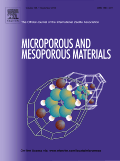
Microporous and Mesoporous Materials
Scope & Guideline
Advancing Knowledge in Microporous Innovations
Introduction
Aims and Scopes
- Synthesis of Porous Materials:
The journal covers diverse methods for synthesizing microporous and mesoporous materials, including zeolites, metal-organic frameworks (MOFs), covalent organic frameworks (COFs), and porous carbons, focusing on innovative techniques to optimize their structural and functional properties. - Characterization Techniques:
Research articles often detail advanced characterization techniques such as X-ray diffraction, electron microscopy, and spectroscopy to analyze the structural, chemical, and textural properties of the synthesized materials. - Catalytic Applications:
A significant focus is placed on the catalytic applications of these materials, exploring their use in reactions such as oxidation, hydrogenation, and carbon dioxide conversion, which are crucial for developing sustainable chemical processes. - Environmental Remediation:
The journal also explores the use of porous materials for environmental applications, including the adsorption and removal of pollutants from air and water, showcasing their potential in addressing environmental challenges. - Energy Storage and Conversion:
Research on the application of porous materials in energy storage systems, such as supercapacitors and batteries, highlights their role in enhancing energy efficiency and sustainability.
Trending and Emerging
- Green Synthesis Techniques:
An increasing number of articles focus on eco-friendly and sustainable synthesis methods for porous materials, highlighting the importance of reducing environmental impact in material production. - Multifunctional Materials:
There is a growing interest in developing multifunctional porous materials that can serve multiple purposes, such as catalysis and adsorption, or energy storage and environmental remediation, reflecting a trend towards integrated solutions. - Advanced Characterization Techniques:
Emerging trends include the application of advanced characterization techniques, such as in situ spectroscopy and molecular simulations, to better understand the behavior and properties of porous materials under various conditions. - Nanostructured and Hybrid Materials:
Research on nanostructured and hybrid porous materials is on the rise, focusing on combining different material types to enhance performance in applications like catalysis and drug delivery. - CO2 Capture and Utilization:
There is a significant emphasis on developing materials for carbon capture and utilization, reflecting global efforts to mitigate climate change through innovative technologies.
Declining or Waning
- Traditional Adsorption Studies:
Research focusing solely on traditional adsorption isotherms without incorporating advanced modeling or new materials appears to be less frequent, as the field moves towards more complex interactions and multifunctional materials. - Basic Zeolite Synthesis Techniques:
There is a noticeable decrease in publications centered on conventional zeolite synthesis methods, with a shift towards innovative and environmentally friendly synthesis routes, reflecting the evolving landscape of zeolite research. - Single-Component Catalysis:
The emphasis on single-component catalytic systems is waning, as the field increasingly explores bimetallic and multifunctional catalytic systems that demonstrate enhanced activity and selectivity. - Non-Eco-Friendly Synthesis Methods:
Research utilizing non-eco-friendly synthesis methods is becoming less common, as the community prioritizes sustainability and green chemistry practices.
Similar Journals

JOURNAL OF POROUS MATERIALS
Innovating Through the Lens of PorosityJOURNAL OF POROUS MATERIALS, published by SPRINGER, is an esteemed peer-reviewed journal in the field of materials science and engineering, with a particular focus on porous materials, their properties, and applications. Since its inception in 1995, this journal has become a pivotal platform for innovative research, offering a robust repository of knowledge with a timeline extending through to 2024. The journal is recognized for its influential contributions, as evidenced by its Q2 quartile ranking in both Materials Science and Mechanical Engineering categories, and its strong performance in Scopus rankings, placing it in the 71st percentile for Mechanical Engineering. Researchers and professionals in the field will find essential insights into the latest advancements and interdisciplinary approaches related to porous materials. While the journal operates under a subscription model, its reach and significance in advancing the understanding of porous materials make it a vital resource for academics and industry practitioners seeking to apply cutting-edge research to real-world challenges.

ADVANCED FUNCTIONAL MATERIALS
Empowering Researchers with Open Access to Groundbreaking DiscoveriesADVANCED FUNCTIONAL MATERIALS is a leading journal published by WILEY-V C H VERLAG GMBH, prominently recognized in the fields of biomaterials, chemistry, condensed matter physics, and materials science. With an impressive impact factor and a distinguished position in the Q1 quartile across multiple categories including nanoscience and nanotechnology, this journal serves as a vital platform for researchers and professionals committed to innovating in functional materials. Since its inception in 2000, ADVANCED FUNCTIONAL MATERIALS has published high-quality peer-reviewed articles that push the boundaries of materials science, exploring new frontiers in electronic, optical, and magnetic materials. The journal's dedication to open access ensures that its groundbreaking findings are readily available to a global audience, fostering collaboration and knowledge-sharing among scholars and practitioners in the field. For those seeking to stay at the forefront of materials research, ADVANCED FUNCTIONAL MATERIALS is an essential resource.

Inorganic and Nano-Metal Chemistry
Advancing Knowledge in Inorganic Chemistry and Nanotechnology.Inorganic and Nano-Metal Chemistry is a premier journal published by Taylor & Francis Inc, focusing on innovative research and advancements in the fields of inorganic chemistry and nano-metal applications. With an increasing impact in the academic community, this journal has established itself within the Q3 category of both Inorganic Chemistry and Physical and Theoretical Chemistry as of 2023, reflecting its global recognition and influence. The journal is accessible as an Open Access publication, ensuring that research findings are freely available to a broad audience, promoting transparency and collaboration in scientific exploration. Based in the United Kingdom, Inorganic and Nano-Metal Chemistry aims to disseminate high-quality peer-reviewed articles that not only highlight fundamental studies but also push the boundaries of technological applications in areas such as catalysis, materials science, and nanotechnology. Researchers, professionals, and students will find this journal an invaluable resource for the latest developments and interdisciplinary insights in the ever-evolving landscape of inorganic and nano-metal chemistry.
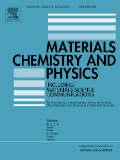
MATERIALS CHEMISTRY AND PHYSICS
Connecting Science and Innovation in Materials ResearchMATERIALS CHEMISTRY AND PHYSICS is a leading peer-reviewed journal published by Elsevier Science SA, focusing on the intersection of materials science and condensed matter physics. With an esteemed impact factor and a distinguished reputation in its field, this journal holds a Q1 ranking in Condensed Matter Physics and a Q2 ranking in miscellaneous Materials Science categories as of 2023. Spanning over three decades since its inception in 1983, it provides a vital platform for researchers, professionals, and students to disseminate cutting-edge findings and innovations in materials characterization, properties, and applications. The journal is indexed in Scopus, boasting impressive rankings that reflect its commitment to publishing high-quality research. Although it does not currently offer an Open Access option, it remains an essential resource for those seeking to stay at the forefront of materials chemistry and physics.

JOURNAL OF MATERIALS SCIENCE
Pioneering Research for Tomorrow's MaterialsJOURNAL OF MATERIALS SCIENCE, published by SPRINGER, stands as a highly regarded periodical in the field of materials science, delivering impactful research since its inception in 1966. With an impressive Q1 ranking in both Mechanical Engineering and Mechanics of Materials, alongside strong Q2 positions in Ceramics, Composites, and General Materials Science, this journal serves as a pivotal resource for scholars and practitioners alike. It offers insightful contributions that span a diverse range of topics, from emerging materials to advanced applications in engineering. With a robust Scopus ranking reflecting its global influence—ranking 91 out of 672 in Mechanical Engineering and 63 out of 398 in Mechanics of Materials—the JOURNAL OF MATERIALS SCIENCE maintains an essential role in advancing the understanding and innovation within the discipline. Researchers, professionals, and students are encouraged to access this esteemed journal to keep abreast of groundbreaking findings and methodologies that shape the future of materials science.
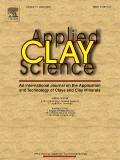
APPLIED CLAY SCIENCE
Exploring the Intersection of Geochemistry and GeologyAPPLIED CLAY SCIENCE, published by Elsevier, is a leading international journal dedicated to the dissemination of high-quality research in the fields of geochemistry, geology, soil science, and water science and technology. With its ISSN 0169-1317 and E-ISSN 1872-9053, this peer-reviewed journal has been an essential resource for researchers since its inception in 1985 and is set to continue its impactful journey through 2024. Recognized for its significant contributions, it proudly holds a Q1 ranking in multiple categories according to the latest assessments, including Geochemistry and Petrology, and Geology, ranking 5th and 10th respectively in Scopus. This journal serves as a vital platform for the advancement of knowledge surrounding clay science, exploring both fundamental and applied research that addresses contemporary challenges in environmental and geological sciences. Whether accessed via institutional subscriptions or individual purchase, APPLIED CLAY SCIENCE is dedicated to fostering an open dialogue among scientists, professionals, and educators in the discipline.
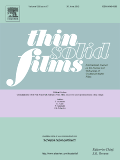
Thin Solid Films
Connecting Theory and Application in Thin Film StudiesThin Solid Films, published by ELSEVIER SCIENCE SA, is a highly regarded journal in the fields of materials science and physics, specifically focused on the properties and applications of thin films. Established in 1967, this journal has been a leading platform for disseminating research on surfaces, coatings, and advanced materials. With its consistent publication through the notable HIndex of scholarly impact, this journal showcases a diverse range of studies ranging from electronic, optical, and magnetic materials to novel surface and interface engineering. In recent evaluations, Thin Solid Films has achieved significant rankings, including a Q2 position in Materials Chemistry and Metals and Alloys, reflecting its relevance and importance in ongoing scientific discourse. Although it does not offer open access, it provides a vital resource for researchers, professionals, and students seeking to advance their knowledge and expertise in thin film technology. The journal's commitment to quality and innovation makes it an essential publication for anyone engaged in the field.

Advanced Powder Materials
Catalyzing Research in Advanced MaterialsAdvanced Powder Materials, published by KEAI PUBLISHING LTD, stands at the forefront of research in materials science, particularly focusing on the intricate relationships within powder materials and their applications across several domains including catalysis, ceramics, energy, and coatings. With an Open Access policy initiated in 2022, this journal ensures that cutting-edge findings are readily accessible to researchers, professionals, and students globally. Based in Beijing, China, the journal has gained recognition for its exceptional impact, achieving a prestigious Q1 ranking in multiple categories such as Catalysis, Ceramics and Composites, and Materials Science. The journal not only promotes innovative research but also serves as a vital platform for interdisciplinary collaboration, significantly impacting the fields it covers, which also include notable rankings in Metals and Alloys and Surfaces, Coatings, and Films. By fostering an environment of knowledge sharing, Advanced Powder Materials is poised to make substantial contributions to the scientific community over its converged years from 2022 to 2024.

JOURNAL OF ELECTROCERAMICS
Exploring the Intersection of Theory and PracticeJOURNAL OF ELECTROCERAMICS, published by SPRINGER in the Netherlands, serves as a pivotal platform for advancing the field of electroceramics since its inception in 1997. With a keen focus on innovative materials and applications, this journal covers diverse areas encompassing ceramics and composites, condensed matter physics, and electronic materials, significantly contributing to interdisciplinary research. Although currently not an Open Access publication, the journal's engagement in rigorous peer review ensures the dissemination of high-quality research, supported by its respectable Q3 ranking in several relevant categories in 2023. Researchers and professionals will find value in its comprehensive scope, showcasing cutting-edge developments that shape the future of engineering and materials science. The JOURNAL OF ELECTROCERAMICS continues to play a crucial role in bridging theoretical discoveries with practical applications, making it an indispensable resource for students, scholars, and industry experts alike.
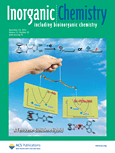
INORGANIC CHEMISTRY
Transforming Ideas into Insights in Inorganic ChemistryInorganic Chemistry, published by the American Chemical Society, stands at the forefront of the field of inorganic and physical chemistry, boasting an impressive impact in the academic community with a 2023 classification in the Q1 quartile across multiple categories including Inorganic Chemistry and Miscellaneous Chemistry. Since its inception in 1962, this esteemed journal has been a crucial platform for disseminating groundbreaking research, innovative methodologies, and comprehensive reviews integral to understanding the complex behaviors of inorganic materials. With a ranking of #12 out of 79 in Inorganic Chemistry and #37 out of 189 in Physical and Theoretical Chemistry according to Scopus metrics, Inorganic Chemistry has established itself as a premier destination for researchers, professionals, and students alike, eager to stay abreast of pivotal developments and trends in the discipline. Despite being a subscription-based journal, its esteemed reputation and critical contributions make it essential for anyone engaged in the exploration of inorganic chemical phenomena. As it prepares to converge into a new era by 2024, the journal continues to embody excellence and innovation, fostering a dynamic exchange of ideas essential for advancing this vibrant area of science.